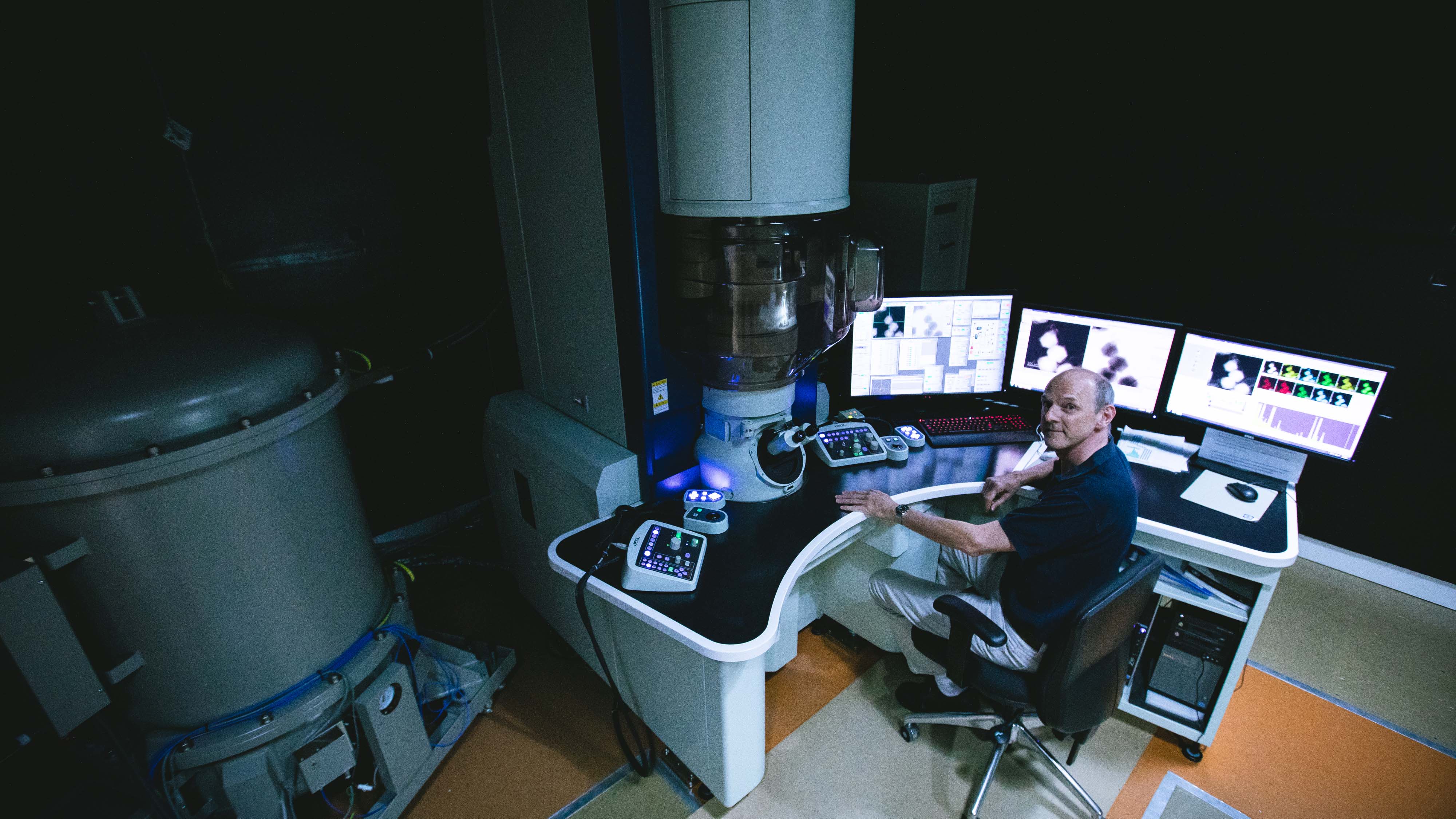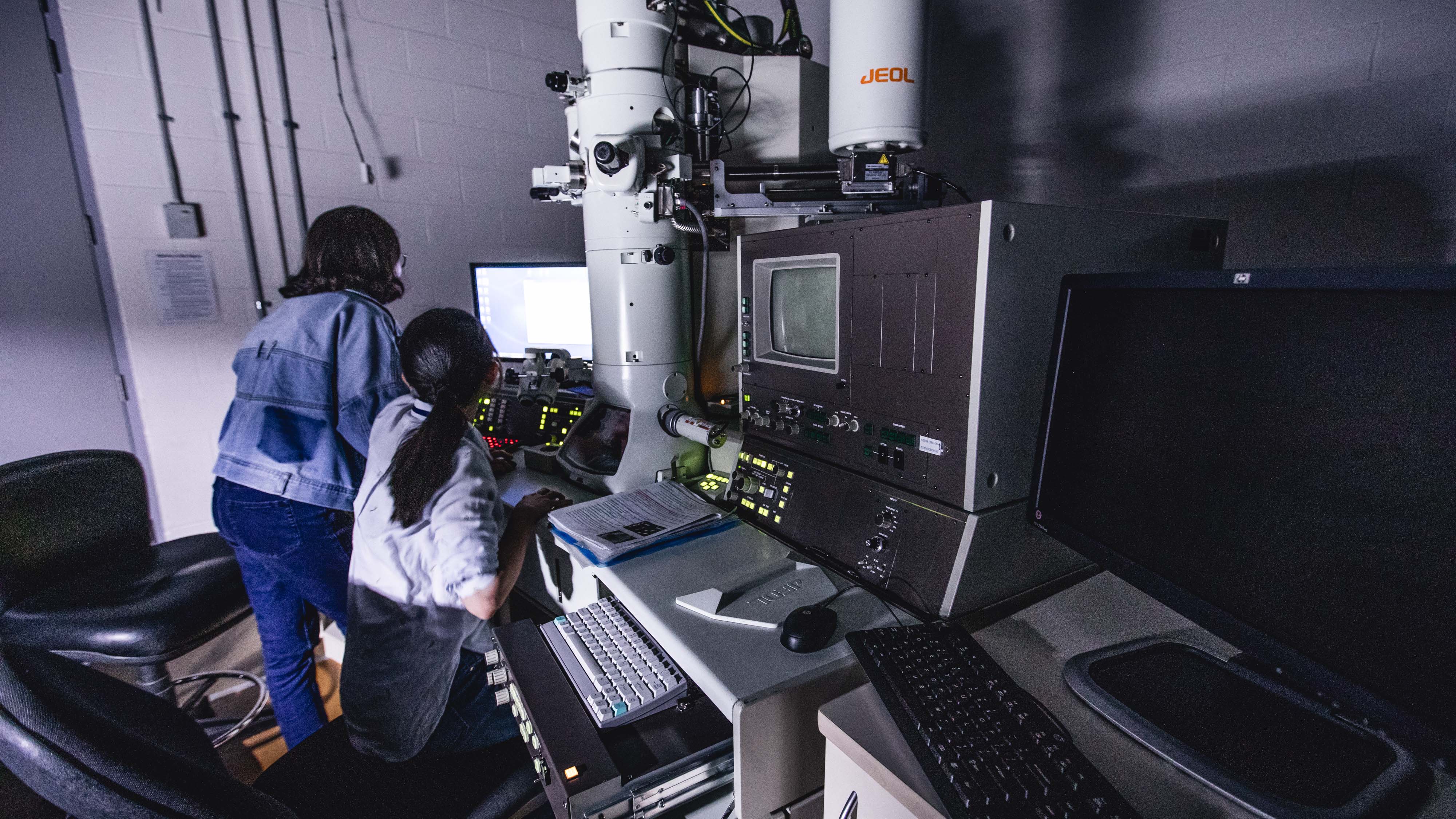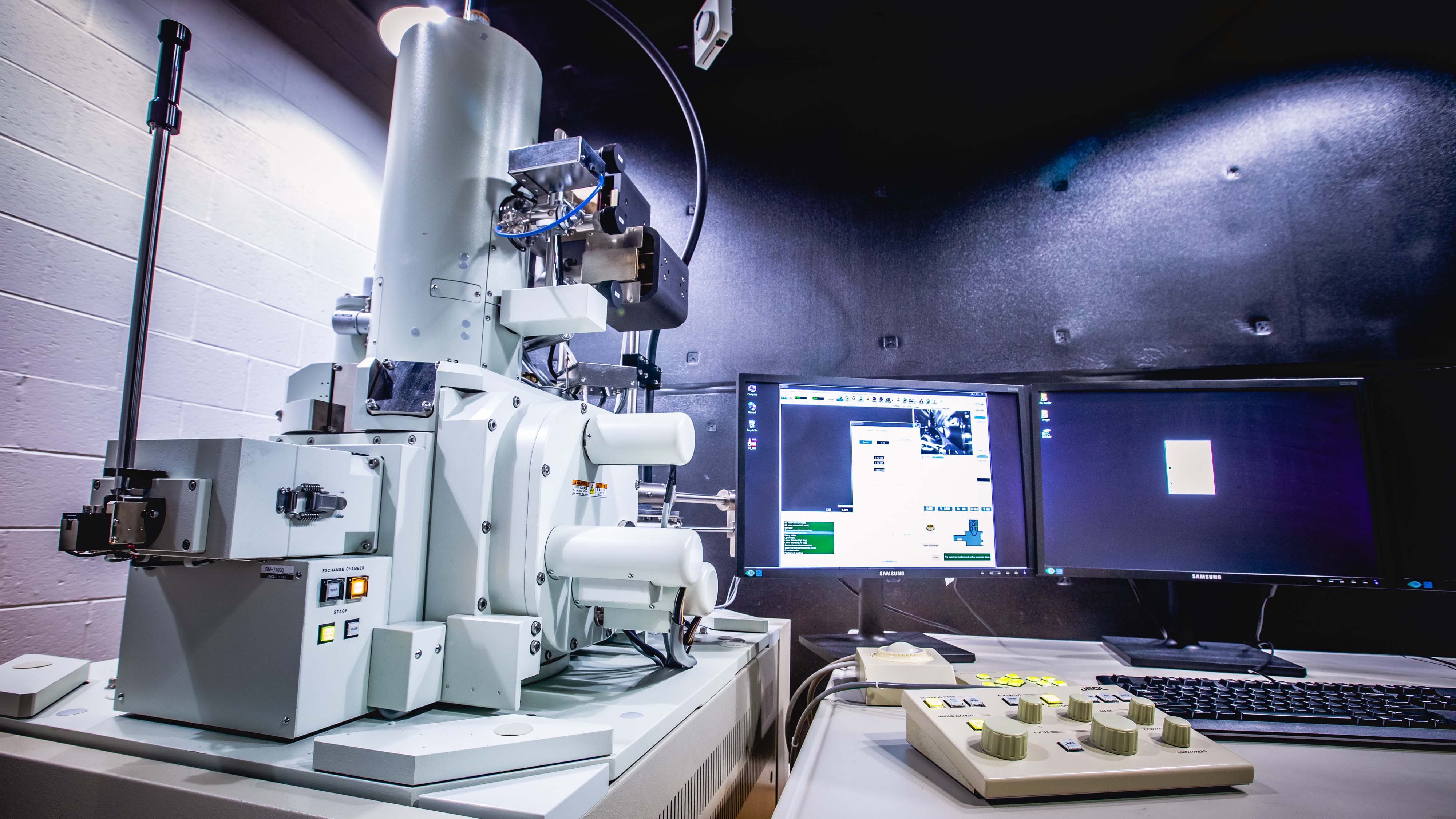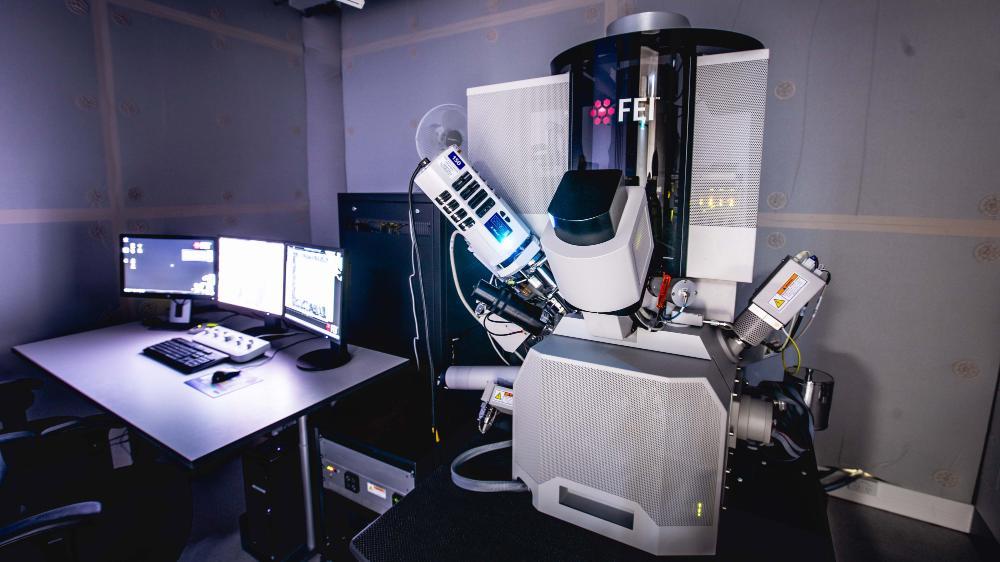The EMC houses three transmission electron microscopes, three scanning electron microscopes, a dual beam focused ion beam and a wide range of instrumentation for optical microscopy and sample preparation.
For more information, please contact the EMC staff.
Transmission electron microscopes
JEOL JEM-ARM200F

The JEOL JEM-ARM200F is a 200kV probe corrected scanning transmission electron microscope (STEM) capable of atomic resolution imaging. At 200 kV the microscope features a resolution of <0.08 nm, while at 80 kV a resolution of <0.14 nm.
The microscope features a large area SDD EDS detector that allows elemental mapping with atomic resolution. Moreover, the microscope is equipped with a Cold Field Emission Gun with a resolution of 0.3 eV, which coupled with the GIF Quantum imaging filter, enables not elemental analysis at the atomic level determination of electronic structure; i.e., oxidation state, chemical bonding, surface plasmons, etc.
- HAADF, ABF, SE/BSE STEM detectors
- HR pole piece with up to 35o tilt range.
- Tomography insert with up to 70o tilt range.
- JEOL Cold holder (Liquid nitrogen temperature).
- JEOL Centurio SDD detector with 100 mm2 detection area (~1 sr).
- Gatan UltraScan 1000XP CCD camera (2k x 2k).
- Gatan Quantum 963 SE imaging filter.
Specialists: Dr Lachlan Smillie
JEOL JEM-F200

The JEOL JEM-F200 is a cold FEG TEM/STEM capable of running at 200 or 80 kV. At 200 kV the microscope features a resolution of 0.23 nm in TEM mode and 0.16 nm in STEM mode.
The microscope features two large area (1.7 Sr) EDS SDDs suitable for high throughput elemental mapping for elements above Li, and quantisation for elements above F.
The microscope additionally features a Segmented Annular All Field Detector (SAAF) which is suitable for STEM imaging of, for example, magnetic domains.
The microscope is also equipped with:
- Conventional STEM BF and ADF/HAADF detectors.
- A Gatan RIO CMOS TEM camera with 4k by 4k resolution capable of 20-160 FPS.
- An autoloader for compatible single and double tilt specimen holders.
- Heating, cooling and mechanical testing specimen holders can also be used with manual loading.
- HR pole piece with up to 35o tilt range
- Tomography insert with up to 70o tilt range.
Specialists: Dr Lachlan Smillie, Dr Qiang Zhu
JEOL JEM-2011

The JEOL JEM2011 is a 200 kV conventional LaB6 transmission electron microscope with a spatial resolution of 0.16 nm.
The microscope is also capable of STEM imaging in HAADF, ADF and BF modes using a ADF/BF detector.
The SiLi EDS detector enables compositional analysis in TEM mode and elemental mapping in STEM mode. It is ideal for routine TEM imaging and for sample screening before analysing samples in the aberration corrected STEM.
- Gatan Orius CCD camera (4k by 2k).
- Lorentz imaging.
- Tomography insert with up to 70o tilt range.
- ADF/BF detector.
- HR pole piece with up to 35o tilt range.
- JEOL JED-2300 EDS detector with a 30 mm2 detection area.
Specialists: Dr. David Wexler, Dr. Lachlan Smillie
Scanning electron microscopes
JEOL JSM-7001F

The JEOL JSM-7001F is a 30 kV analytical thermal field emission gun scanning electron microscope capable of 3 nm spatial resolution. It is well suited for the detailed characterisation of conductive/coated samples. The large area EDS detector enables rapid quantitative microanalysis and elemental mapping while the high resolution EBSD system enables orientation mapping in scanning and transmission modes.
- SE, segmented Si BSE detectors
- Up to 40 mm diameter, 500 gm samples on a 5-axis compu-centric sample stage
- Oxford Instruments Nordlys II(S) high resolution EBSD camera
- Oxford Instruments X-Max 80 80 mm2, 123 eV SDD energy dispersive X-ray detector
- Integrated AZtecSynergy software suite comprising AZtecHKL for EBSD and AZtecEnergy for EDS along with INCAFeature particle analysis.
Specialists: Dr Azdiar Gazder, Dr Qiang Zhu
JEOL JSM-7500FA

The JEOL JSM-7500FA is a 30 kV semi in-lens cold field emission gun scanning electron microscope capable of 1.4 nm spatial resolution. It is well suited for the characterisation of insulating and nanomaterials, medical and biological samples. The gentle beam irradiation technique provides exceptional image quality at acceleration voltages as low as 0.1kV. This reduces charging effects in uncoated insulating materials and beam damage in electron-sensitive materials. The transmitted electron detector can attain a resolution of 0.6nm at 30 kV and is suitable for imaging thin foils or nanosized materials on thin support films.
- SE, BSE, transmission detectors
- Up to 40 mm diameter, 500 gm samples on a 5-axis compu-centric sample stage
- Bruker X-Flash 4010 10 mm2, 127 eV SDD energy dispersive X-ray detector
- Bruker Quantax for quantitative X-ray mapping and Esprit Steel microanalysis software suites for particle analysis
Specialists: Dr Azdiar Gazder, Dr Qiang Zhu
JEOL JSM-6490LA
The JEOL JSM-6490LA is a 30 kV conventional tungsten filament, variable pressure scanning electron microscope. It is well suited for basic structural imaging of large (or component sized) engineering materials and wet, biological or cryogenic samples at a maximum resolution of 3.5 nm (at 30 kV). The large area EDS detector enables rapid quantitative microanalysis and elemental mapping while the cathodoluminescence spectrometer allows investigation of trace elements, electronic structure and stress in a range of non-metallic materials.
-
SE and BSE detectors
- Up to 250 x 75 mm2 samples on a 5-axis eucentric sample stage
- Oxford Instruments X-MaxN 80 80 mm2, 123 eV SDD energy dispersive X-ray detector
- Integrated AZtecSynergy software suite comprising AZtecEnergy for EDS along with AZtecFeature particle analysis.
- Gatan MonoCL4 cathodoluminescence spectrometer with a monochromatic detection range of 185-850nm (resolution <0.5nm) and panchromatic RGB filters for rapid imaging.
Specialists: Dr Mitchell Nancarrow, Dr Qiang Zhu
Focussed ion beam FEGSEM

The FEI Helios NanoLab G3 CX is a state-of-the-art dual (electron and ion) beam analytical scanning electron microscope and highly targeted sectioning tool. Using the focused ion beam 3D analytical datasets of electron images and EDS/EBSD datasets can be generated though serial sectioning of a region of interest (up to ~50 um3) or to prepare targeted electron transparent lamella for high resolution TEM investigation or atom probe samples. A new capability for this class of tool is to perform mass spectroscopy of the ions ablated during milling to yield very high resolution (~100 nm2) elemental maps of light elements (down to Li) which is difficult or impossible with X-ray based analytical methods.
- SE, BSE and STEM detectors
- Pt, C and N2 (charge neutralisation) gas injection
- Samples must fit within a 25 mm radius and be less than 10 mm high for general samples
- Oxford instruments X-maxN 150 mm2 123eV SDD energy dispersive X-ray detector
- Oxford instruments NordlysMax 3 High speed EBSD camera
- Integrated AZtec synergy software suite comprising AZtec HKL for EBSD and AZtec energy and AZtec ED and EBS4 for 3D dataset acquisition and analysis
- FEI Avizo 3D analysis and image processing suite
- Secondary ion mass spectrometer
Specialists: Dr Mitchell Nancarrow, Dr Qiang Zhu, Dr Azdiar Gazder.
In-situ capabilities
PI-95 TEM Pico-Indenter
The Bruker PI 95 TEM Pico indenter enables researchers to probe the mechanical properties of nano-sized materials inside the transmission electron microscope. The holder is able to acquire quantitative nanoscale mechanical data in different modes including compression, tension, bending and scratching, while the high spatial resolution of the TEM allows for simultaneous observation and recording of the deformation phenomena, such as dislocation bursts, phase transformations, shear banding, etc. Licenced TEM users could be trained to use this holder. Standard TEM usage charges applied.
Gatan 652 In-situ Heating Holder
This holder takes standard 3mm disk-type TEM specimens. These can be either bulk foils or nanoparticles on support films (on grids). The holder has an operating temperature range up to 900 deg C routinely, and up to 1000 deg C for very short intervals. It features double tilting (+/- 25 degs), which permits crystallographic studies of such phenomena as phase transformations and recrystallization. It is compatible with both of the EMC’s JEOL TEMs. EDS analysis/mapping cannot be done during heating, due to infrared radiation blinding the detector. However, analysis after the holder has cooled back down to room temperature is possible, albeit with a small collection angle. Due to thermal drift, high resolution studies are not practical with this type of holder. However, imaging at up to several hundred thousand times is feasible. Access to this specialised holder is fully supported via EMC staff. Experiments should be very carefully planned as in-situ heating often leads to results which differ from bulk data, due to surface and thin specimen effects and oxidation inside the microscope. Detailed thermal properties (eg DTA/TGA) of the material to be studied MUST be provided beforehand, to identify the temperatures of interest and to avoid the risk of phases melting during heating, which can cause very costly damage both to the holder and to the microscope. There is no additional charge for using this holder (aside from fully supported microscope usage costs). The holder uses sacrificial tantalum washers to prevent specimens sticking to the holder. In the event that the specimen sticks to the washers, the user will be charged for replacement costs at $50 per pair.
In-situ testing stage for FEGSEM
The Micomecha SAS 3 kN deformation stage works within the JEOL 7001F FEG-SEM for in-situ imaging/EDS/EBSD/EDS+EBSD work or on a benchtop as a sub-size sample mechanical property tester. Its capabilities are as follows:
- Room temperature tension, compression, 3 point bend, bi-axial tension and shear
- The ability to heat standard size dog-bone samples to 600 °C along with the ability to semi-quench them through the passage of a liquid inside the SEM chamber.
- A cooling module capable of cooling down to liquid nitrogen temperature.
The use of this stage is fully supported by EMC staff. Special usage charges covering both microscope time and stage are applied: for the first 6 hrs within the 24hr period - $210, each subsequent hour is $10. No subscription discount is available.
Contact: Dr Azdiar Gazder
Thermo Scientific™ μHeater holder
The μHeater is a high-vacuum compatible, ultra-fast heating holder for in-situ investigations of small samples (i.e. lamella, nanoparticles) up to 1200°C. The μHeater uses small MEMS based chips (consumables) as a heater, which rapidly heat a sample at a rate of 0.01 to 104 °C/s with temperature settling to within 1 °C. The μHeater is fully integrated in the Helios NanoLab CX G3 dual beam instrument. All standard analytical channels including EBSD, EDS and SIMS are available during all experiments.
The μHeater has an additional four contacts that can be used for biasing experiments up to ±40V and/or for sample resistance measurement.
The use of this holder is fully supported by EMC staff.
Contact: Dr Mitchell Nancarrow
Optical microscopes
- Leica DM 2500M upright microscope
- Leica DM 6000M upright microscope
- Leica M 205A upright stereo microscope
Sample preparation
- Allied high hech TEM wedge polisher
- Gatan precision ion polishing system (PIPS) Model 691
- Gatan 601 Ultrasonic cutter: for machining disks and other shapes from semiconductor/ceramic wafers.
- Gatan 623 Disc Grinder: for precision grinding small (<5mm) specimens to specific thicknesses with +/- 5 micron precision
- Gatan 656 Dimple Grinder: for precision thinning of TEM disks prior to ion milling.
- Leica EM CPD030 critical point dryer
- Leica EM RES101 ion milling system
- Leica EM TIC020triple ion beam miller/cutter
- Leica EM TXP target surfacing system
- Leica EM UC7 Ultramicrotome for room temperature and cryo serial sectioning
- Struers Accustop for controlled material removal and target preparation
- Struers Accutom-50 precision cut-off machine
- Struers Axitom-5 precision cut-off machine
- Struers Citopress-20 hot mounting press
- Struers Citovac-20 cold mounting and vacuum impregnator
- Struers Labopol-25 grinding machine
- Struers Tegramin-25 auto-polisher (water)
- Struers Tegramin-25 auto-polisher (alcohol)
- Struers Lectropol-5 bulk sample electropolisher
- Struers Tenupol-5 twin jet TEM disc electropolisher
- Teclock PC-465J micrometre
Other equipment
- Edwards Auto 306 thermal evaporator/vacuum coating system
- Edwards TIC vacuum pumping station and desiccator for SEM and TEM samples
- JEOL EC-52000IC ion cleaner for TEM holders/samples
- JEOL EM-21090 cryogenic holder and EM-SHU2 control unit for TEM at -160°C
- JEOL JEC-4000DS dry pumping station for TEM holders
- Kammerath & Weiss GmbH 3 kN tension/compression stage with resistance heating up to 900°C
- Leica EM KMR3 Glass knifemaker
- Struers Emco-Test DuraScan-70 Vickers hardness tester (10 gm to 10 kg)
- XEI Scientific Evactron-25 decontaminator/plasma cleaner for TEM holders and SEM and TEM samples